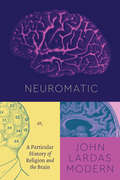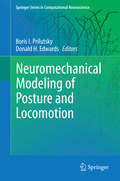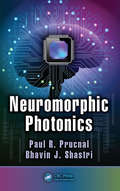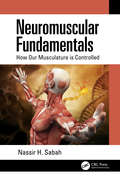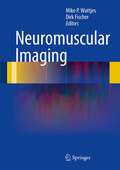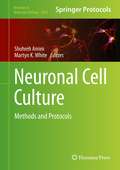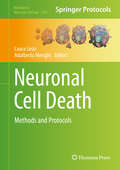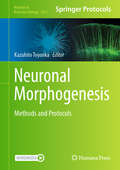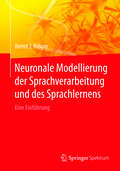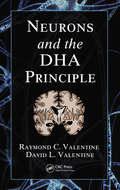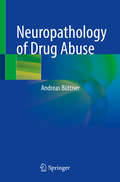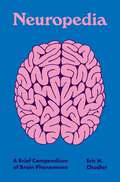- Table View
- List View
Neuromatic: Or, A Particular History of Religion and the Brain (Class 200: New Studies in Religion)
by John Lardas ModernJohn Modern offers a powerful and original critique of neurology’s pivotal role in religious history. In Neuromatic, religious studies scholar John Lardas Modern offers a sprawling examination of the history of the cognitive revolution and current attempts to locate all that is human in the brain, including spirituality itself. Neuromatic is a wildly original take on the entangled histories of science and religion that lie behind our brain-laden present: from eighteenth-century revivals to the origins of neurology and mystic visions of mental piety in the nineteenth century; from cyberneticians, Scientologists, and parapsychologists in the twentieth century to contemporary claims to have discovered the neural correlates of religion. What Modern reveals via this grand tour is that our ostensibly secular turn to the brain is bound up at every turn with the religion it discounts, ignores, or actively dismisses. In foregrounding the myths, ritual schemes, and cosmic concerns that have accompanied idealizations of neural networks and inquiries into their structure, Neuromatic takes the reader on a dazzling and disturbing ride through the history of our strange subservience to the brain.
Neuromatic: Or, A Particular History of Religion and the Brain (Class 200: New Studies in Religion)
by John Lardas ModernJohn Modern offers a powerful and original critique of neurology’s pivotal role in religious history. In Neuromatic, religious studies scholar John Lardas Modern offers a sprawling examination of the history of the cognitive revolution and current attempts to locate all that is human in the brain, including spirituality itself. Neuromatic is a wildly original take on the entangled histories of science and religion that lie behind our brain-laden present: from eighteenth-century revivals to the origins of neurology and mystic visions of mental piety in the nineteenth century; from cyberneticians, Scientologists, and parapsychologists in the twentieth century to contemporary claims to have discovered the neural correlates of religion. What Modern reveals via this grand tour is that our ostensibly secular turn to the brain is bound up at every turn with the religion it discounts, ignores, or actively dismisses. In foregrounding the myths, ritual schemes, and cosmic concerns that have accompanied idealizations of neural networks and inquiries into their structure, Neuromatic takes the reader on a dazzling and disturbing ride through the history of our strange subservience to the brain.
Neuromechanical Modeling of Posture and Locomotion
by Boris I. Prilutsky Donald H. EdwardsNeuromechanics is a new, quickly growing field of neuroscience research that merges neurophysiology, biomechanics and motor control and aims at understanding living systems and their elements through interactions between their neural and mechanical dynamic properties. Although research in Neuromechanics is not limited by computational approaches, neuromechanical modeling is a powerful tool that allows for integration of massive knowledge gained in the past several decades in organization of motion related brain and spinal cord activity, various body sensors and reflex pathways, muscle mechanical and physiological properties and detailed quantitative morphology of musculoskeletal systems. Recent work in neuromechanical modeling has demonstrated advantages of such an integrative approach and led to discoveries of new emergent properties of neuromechanical systems. Neuromechanical Modeling of Posture and Locomotion will cover a wide range of topics from theoretical studies linking the organization of reflex pathways and central pattern generating circuits with morphology and mechanics of the musculoskeletal system (Burkholder; Nichols; Shevtsova et al. ) to detailed neuromechanical models of postural and locomotor control (Bunderson; Edwards, Marking et al. , Ting). Furthermore, uniquely diverse modeling approaches will be presented in the book including a theoretical dynamic analysis of locomotor phase transitions (Spardy and Rubin), a hybrid computational modeling that allows for in vivo interactions between parts of a living organism and a computer model (Edwards et al. ), a physical neuromechanical model of the human locomotor system (Lewis), and others.
Neuromorphic Circuits for Nanoscale Devices
by Pinaki Mazumder Yalcin Yilmaz Idongesit EbongNanoscale devices attracted significant research effort from the industry and academia due to their operation principals being based on different physical properties which provide advantages in the design of certain classes of circuits over conventional CMOS transistors. Neuromorphic Circuits for Nanoscale Devices contains recent research papers presented in various international conferences and journals to provide insight into how the operational principles of the nanoscale devices can be utilized for the design of neuromorphic circuits for various applications of non-volatile memory, neural network training/learning, and image processing. The topics discussed in the book include:Nanoscale Crossbar Memory DesignQ-Learning and Value Iteration using Nanoscale DevicesImage Processing and Computer Vision Applications for Nanoscale DevicesNanoscale Devices based Cellular Nonlinear/Neural Networks
Neuromorphic Engineering: The Scientist’s, Algorithms Designer’s and Computer Architect’s Perspectives on Brain-Inspired Computing
by Elishai Ezra TsurThe brain is not a glorified digital computer. It does not store information in registers, and it does not mathematically transform mental representations to establish perception or behavior. The brain cannot be downloaded to a computer to provide immortality, nor can it destroy the world by having its emerged consciousness traveling in cyberspace. However, studying the brain's core computation architecture can inspire scientists, computer architects, and algorithm designers to think fundamentally differently about their craft. Neuromorphic engineers have the ultimate goal of realizing machines with some aspects of cognitive intelligence. They aspire to design computing architectures that could surpass existing digital von Neumann-based computing architectures' performance. In that sense, brain research bears the promise of a new computing paradigm. As part of a complete cognitive hardware and software ecosystem, neuromorphic engineering opens new frontiers for neuro-robotics, artificial intelligence, and supercomputing applications. This book will present neuromorphic engineering from three perspectives: the scientist, the computer architect, and the algorithm designer. We will zoom in and out of the different disciplines, allowing readers with diverse backgrounds to understand and appreciate the field. Overall, the book will cover the basics of neuronal modeling, neuromorphic circuits, neural architectures, event-based communication, and the neural engineering framework. Readers will have the opportunity to understand the different views over the inherently multidisciplinary field of neuromorphic engineering.
Neuromorphic Intelligence: Learning, Architectures and Large-Scale Systems (Synthesis Lectures on Engineering, Science, and Technology)
by Badong Chen Shuangming YangThis book provides a valuable resource on the design of neuromorphic intelligence, which serves as a computational foundation for building compact and low-power brain-inspired intelligent systems. The book introduces novel spiking neural network learning algorithms, including spike-based learning based on the multi-compartment model and spike-based learning with information theory. These offer important insights and academic value for readers to grasp the latest advances in neural-inspired learning. Additionally, the book presents insights and approaches to the design of scalable neuromorphic architectures, which are crucial foundations for achieving highly cognitive and energy-efficient computing systems. Furthermore, the book introduces representative large-scale neuromorphic systems and reviews several recently implemented large-scale digital neuromorphic systems by the authors, providing corresponding application scenarios.
Neuromorphic Olfaction
by Santiago Marco Krishna C. Persaud Agustín Gutiérrez-GálvezMany advances have been made in the last decade in the understanding of the computational principles underlying olfactory system functioning. Neuromorphic Olfaction is a collaboration among European researchers who, through NEUROCHEM (Fp7-Grant Agreement Number 216916)-a challenging and innovative European-funded project-introduce novel computing p
Neuromorphic Photonics
by Paul R. Prucnal Bhavin J. ShastriThis book sets out to build bridges between the domains of photonic device physics and neural networks, providing a comprehensive overview of the emerging field of "neuromorphic photonics." It includes a thorough discussion of evolution of neuromorphic photonics from the advent of fiber-optic neurons to today’s state-of-the-art integrated laser neurons, which are a current focus of international research. Neuromorphic Photonics explores candidate interconnection architectures and devices for integrated neuromorphic networks, along with key functionality such as learning. It is written at a level accessible to graduate students, while also intending to serve as a comprehensive reference for experts in the field.
Neuromuscular Disorders: A Comprehensive Review with Illustrative Cases
by Satish V. Khadilkar Rakhil S. Yadav Bhagyadhan A. PatelThis book provides a concise overview of the diagnosis, therapy, and recent updates of various neuromuscular disorders in tabulated form and with illustrative cases. Treating neuromuscular disorders requires a sound, step-by-step clinical approach based on differential diagnosis and laboratory investigations. Yet to date, no single, compact book offers all the relevant information about managing these disorders. This book fills that gap, presenting the state of the art in the field and addressing practical problems with their solutions. Each chapter covers disorder characteristics, clinical differentiating points, relevant investigations, and their interpretation, available genetic testing, best management approaches, and counseling. Illustrative cases provide valuable insights, while extensive tables and illustrations will be helpful for the Neurologist, neuromuscular specialist, Neurology resident, Physician, and physiotherapist.
Neuromuscular Fundamentals: How Our Musculature is Controlled
by Nassir H. SabahThis book is rather unique in its approach and coverage. The approach is essentially that of an engineering textbook, emphasizing the quantitative aspects and highlighting the fundamentals and basic concepts involved. The coverage progresses in a logical and systematic manner from the subcellular, starting with the electrophysiology of the cell membrane, then proceeding to synapses, neurons, and muscle, before considering neuronal motor ensembles and the neuromuscular system as a whole. Simple, clear, and comprehensive explanations are given throughout. After an introductory chapter on some background material in biology, biophysics, and chemical kinetics, a substantial part of the book (Chapters 2-8) necessarily covers in considerable detail the basic components and processes that underlie the electrical and associated activities of the nervous system. The remaining chapters of the book (Chapters 9-13) focus on the neuromuscular system, starting with the structure of muscle cells, the generation of force by muscular contraction, and muscle receptors. The last chapter examines aspects of the control of movement, motor learning and memory, the maintenance of posture, and locomotion, and critically examines some of the theories that have been advanced to explain how movement is controlled. The book is intended for undergraduate or graduate students in the natural sciences, mathematics, or engineering who seek a deeper understanding of the fundamentals of neuroscience and the somatomotor system, in accordance with the aforementioned objectives. The book can serve as a textbook for a one-semester course on the neuromuscular system or as a reference in a more general course on neuroscience. Provides a thorough analytical treatment of membrane electrophysiology, starting from the first principles Emphasizes strongly the basic and fundamental concepts throughout Discusses thoroughly the essential features and properties of the basic constituents of the nervous system, that is, neurons and synapses, including the neuromuscular junction Explains the main aspects of posture, locomotion, and control of movement Includes practice problems throughout the text and a solutions manual will be available for adopting professors Nassir Sabah is professor of biomedical engineering in the electrical and computer engineering department at the American University of Beirut, Lebanon. He received his B.Sc. (Hons. Class I) and his M.Sc. in electrical engineering from the University of Birmingham, U.K., and his Ph.D. in biophysical sciences from the State University of New York (SUNY/Buffalo). He has served as Chairman of the Electrical Engineering Department, Director of the Institute of Computer Studies, and Dean of the Faculty of Engineering and Architecture at the American University of Beirut. In these capacities, he was responsible for the development of programs, curricula, and courses in electrical, biomedical, communications, and computer engineering. Professor Sabah has extensive professional experience in the fields of electrical engineering, electronics, and computer systems, with more than 35 years’ teaching experience in neuroengineering, biomedical engineering, electronics, and electric circuits. He has over 100 technical publications, mainly in neurophysiology, biophysics, and biomedical instrumentation. He has served on numerous committees and panels in Lebanon and the region. He is a Fellow of the Institution of Engineering and Technology (IET, U.K.), a member of the American Association for the Advancement of Science (AAAS), and a member of the American Society for Engineering Education (ASEE).
Neuromuscular Imaging
by Dirk Fischer Mike P. WattjesNeuromuscular imaging has increasingly become an important tool in the detection and diagnosis of inherited and acquired neuromuscular disease. This book is a groundbreaking radiological and neurological overview of current methods and applications of imaging--including aspects of neuroimaging and musculoskeletal imaging--in patients with inherited, metabolic, and inflammatory muscle diseases. Imaging features are discussed in the context of clincial presentation, histopathology, therapeutic options and differential diagnosis. World leading expert contributors give a comprehensive and didactic review of neuromuscular disorders and available imaging modalities, each illustrated with numerous figures. Topics discussed include: -Modalities such as ultrasound, CT and MRI -Muscle anatomy and physiology -Clinical applications in hereditary and acquired myopathies -Clinical applications in motor neuron disorders and peripheral nerve imaging
Neuron Signaling in Metabolic Regulation (Methods in Signal Transduction Series)
by Qingchun TongThis book focuses on neuron signaling in the regulation of metabolism and body weight, and especially on methods used in these studies. Obesity and related metabolic syndromes have reached epidemic status, but still are no effective strategies for prevention and treatment. Body weight homeostasis is maintained by balanced food intake and energy expenditure, both of which are under the control of brain neurons. In the recent years, significant progress has been made in identifying specific neurons, neural pathways, and non-neuron cells in feeding regulation, as well as in delineating autonomic nervous systems targeting peripheral metabolic tissues in the regulation of energy expenditure and metabolism. This book reviews recent progress on important neuron signaling for body weight and metabolic regulation and the state-of-the-art methods that has been applied in this field, ranging from animal models with neuron-specific manipulations, pharmacology, optogenetics, in vivo Ca2+ imaging, and viral tracing. Readers will be exposed to latest research frontiers on neuron regulation of metabolism. Key Features Explores the role signaling between neurons plays with respect to metabolism Documents how neurotransmitters affect the regulation of feeding Describes various methods and technologies used to study the neuronal control of metabolism Includes contributions from an international team of leading researchers. Related Titles Lim, W. & B. Mayer. Cell Signaling: Principles and Mechanisms (ISBN 978-0-8153-4244-1) Feltz, A. Physiology of Neurons (ISBN 978-0-8153-4600-5) Zempleni, J. & K. Dakshinamurti, eds. Nutrients and Cell Signaling (ISBN 978-0367-39307-6)
Neuron-Glia Interaction in Neuroinflammation
by Akio Suzumura Kazuhiro IkenakaAccumulation on glia is an active pathological element in many neurological disorders. Gliosis produces neuroinflammation through both neurotrophic and inflammatory means, but the exact mechanism through which this happens remain unclear. It is suspected that damage to neurons activates the growth of glial cells. The proposed book focuses on the interaction between neurons and glia to help elucidate the pathophysiology of neuroinflammation in neurological disorders.
Neuronal Cell Culture: Methods and Protocols
by Martyn K. White Shohreh AminiIn Neuronal Cell Culture: Methods and Protocols, the latest aspects of the culture of neural cells are explored by experts in the field who also explain the practical and theoretical considerations of the techniques involved. Starting with a general overview of the neuronal culturing principles that are described, this detailed volume covers cell line models for neural cells, the isolation and propagation of primary cultures, stem cells, transfection and transduction of neural cultures, and other more advanced techniques. Written for the Methods in Molecular Biology series, chapters include introductions to their respective topics, lists of the necessary materials and reagents, step-by-step, readily reproducible laboratory protocols, and tips on troubleshooting and avoiding known pitfalls. Practical and easy to use, Neuronal Cell Culture: Methods and Protocols will be of interest to scientists at all levels developing cell culture models for neuroscientific studies.
Neuronal Cell Death
by Adalberto Merighi Laura LossiThis volume represents a valuable and readily reproducible collection of established and emerging techniques for neuronal cell death research. Conveniently divided into four parts, sections cover a series of techniques for the molecular, structural, functional and genomic characterization of dying neurons, a number of protocols that are of primary interest in neuropathology and in experimental neuropathology, a series of gene engineering techniques to obtain and manipulate neuronal stem cells and progenitors, to prepare HSV-1 vectors for the gene therapy, and to CNS transplantation of bone marrow stem cells, and finally, some very interesting protocols for the study of cell death in non-mammalian models. Written in the successful Methods in Molecular Biology series format, chapters include introductions to their respective topics, lists of the necessary materials and reagents, step-by-step, readily reproducible protocols, and notes on troubleshooting and avoiding known pitfalls. Authoritative and easily accessible, Neuronal Cell Death: Methods and Protocols seeks to serve a large audience of scientists that are currently active in the field or are willing to enter such an exciting and still expanding area of neurobiology.
Neuronal Cell Death: Methods and Protocols (Methods in Molecular Biology #2515)
by Arezu Jahani-AslThis volume covers comprehensive methods on ways to assess structural and ultrastructural changes in the mitochondria, cytoskeleton, and microglia using state-of-the-art microscopy techniques including super-resolution imaging, electron microscopy, and ultra-high field MRI. The chapters in this book cover topics such as analysis of neurodegeneration in the post-mortem characterization of preclinical animal models, in vivo modeling in cell death in different model systems and brain organoids, single cell clonal analysis using Mosaic Analysis with Double Markers in genetic mouse models, and genome and proteomic methods for analysis of mRNA dynamics and quantitation of targeted peptides. Written in the highly successful Methods in Molecular Biology series format, chapters include introductions to their respective topics, lists of the necessary materials and reagents, step-by-step, readily reproducible laboratory protocols, and tips on troubleshooting and avoiding known pitfalls.Cutting-edge and thorough, Neuronal Cell Death: Methods and Protocols is a valuable resource for any scientist and researcher interested in learning more about this developing field.
Neuronal Factors (Routledge Revivals)
by J. Regino Perez-PoloFirst Published in 1987, this book offers a full, comprehensive guide into methods and techniques used in Neurobiology. Carefully compiled and filled with a vast repertoire of notes, diagrams, and references this book serves as a useful reference for Neurobiologists, and other practitioners in their respective fields.
Neuronal Morphogenesis: Methods and Protocols (Methods in Molecular Biology #2831)
by Kazuhito ToyookaThis volume details molecular mechanisms that are involved in neuronal morphogenesis, and methods for analyzing these mechanisms. Chapters detail analyzing neuronal morphology in vitro and in vivo using a variety of model systems, including rodents and human induced pluripotent stem cells (hiPSCs). Written in the highly successful Methods in Molecular Biology series format, chapters include introductions to their respective topics, lists of the necessary materials and reagents, step-by-step, readily reproducible laboratory protocols, and key tips on troubleshooting and avoiding known pitfalls. Authoritative and cutting-edge, Neuronal Morphogenesis: Methods and Protocols aims to be suitable for a wide range of readers interested in the mechanisms of neuronal morphology and related neurological disorders.
Neuronal Oscillations of Wakefulness and Sleep: Windows on Spontaneous Activity of the Brain
by Thien Thanh Dang-Vu Richard CourtemancheThe purpose of this work is to review recent findings highlighting the mechanisms and functions of the neuronal oscillations that structure brain activity across the sleep-wake cycle. An increasing number of studies conducted in humans and animals, and using a variety of techniques ranging from intracellular recording to functional neuroimaging, has provided important insight into the mechanisms and functional properties of these brain rhythms. Studies of these rhythms are fundamental not only for basic neuroscience, but also for clinical neuroscience. At the basic science level, neuronal oscillations shape the interactions between different areas of the brain and profoundly impact neural responses to the environment, thereby mediating the processing of information in the brain. At the clinical level, brain oscillations are affected in numerous neurological conditions and might provide useful biomarkers that inform about patients’ evolution and vulnerability. During sleep, these brain rhythms could provide functional support to internal states that govern the basic maintenance of local circuit and systemic interactions. During wake, the rhythmicity of cortical and subcortical circuits have been linked with sensory processing, cognitive operations, and preparation for action. This book will attempt to link together these sleep and wake functional roles at the level of neuroimaging and electroencephalographic measures, local field potentials, and even at the cellular level.
Neuronal Tissue-Nonspecific Alkaline Phosphatase (TNAP)
by Caroline Fonta László NégyessyPhosphatases, such as TNAP are fundamental in regulating the roles of cellular, and consequently numerous body functions. TNAP is a ubiquitous enzyme with a wide spectrum of substrates and specificity. Regulation at the cellular level and the lack of TNAP activity is a lethal condition. Recent findings of a highly specific regional, laminar and subcellular localization of TNAP in the cerebral cortex indicates that in addition to its metabolic and skeletal functions, TNAP also plays a role in regulating cerebral functions, most probably cognition. In fact, TNAP disturbance could result in complex diseases such as epilepsy, developmental retardation and Alzheimer's disease. Available data suggest that, regarding brain functions, TNAP is a potentially important target of clinical research. This book aims to provide an overview of our current understanding of the functions of TNAP in the brain and on other tissues and organs.
Neuronale Modellierung der Sprachverarbeitung und des Sprachlernens: Eine Einführung
by Bernd J. KrögerDieses Buch erläutert die Thematik der Produktion und Wahrnehmung gesprochener Sprache aus neurowissenschaftlicher Sicht. Nach der Darstellung der Grundlagen der Sprachverarbeitung und des Spracherwerbs wird dem Leser ein neurobiologisch basiertes und computerimplementiertes neuronales Simulationsmodell vorgestellt. Diese Einführung in die quantitative und computerimplementierbare Modellierung der Sprachverarbeitung und des Sprachlernens basiert auf einem naturwissenschaftlich orientierten Ansatz zur Beschreibung gesprochener Sprache. Dennoch wird weitgehend auf mathematische Beschreibungen verzichtet.Das Buch spricht Studierende und Wissenschaftler der Bereiche Neurowissenschaften, Informatik, Medizin, Psychologie und Linguistik an, die sich in das Gebiet der Sprachverarbeitung und des Spracherwerbs aus neurowissenschaftlicher Sicht einarbeiten möchten. Es richtet sich aber auch an Anwender, die sich mit der Entwicklung von Software zur Sprachverarbeitung befassen.
Neurons and the DHA Principle
by Raymond C. Valentine David L. ValentineStudies with bacteria and other systems suggest that the omega-3 fatty acid DHA confers great benefits to neurons in maximizing both speed of neural impulses and energy efficiency. Unfortunately, studies also show that DHA's ease of oxidation damages membrane integrity. Exploring this duality, Neurons and the DHA Principle proposes a new model for
Neuropathologie des Drogenmissbrauchs
by Andreas BüttnerDieses Buch bietet einen umfassenden Überblick über den aktuellen Wissensstand zu Neuropathologien infolge von Drogenmissbrauch. In den ersten Kapiteln erhält der Leser detaillierte Informationen über die neurobiologischen Grundlagen des Drogenmissbrauchs und die Ergebnisse von Neuroimaging-Studien bei Drogenabhängigen. Der Schwerpunkt des Werks liegt auf neuropathologischen Befunden bei Drogenabhängigen für die vorherrschenden Substanzen, zu denen Cannabis, Opiate, Kokain, Amphetamin, Methamphetamin und ein breites Spektrum von Designerdrogen gehören. Diese Befunde werden durch histologische Abbildungen untermauert und im Zusammenhang mit aktuellen wissenschaftlichen Veröffentlichungen diskutiert. Das Buch enthält auch ein Kapitel, das sich speziell an Kliniker richtet und die Auswirkungen auf die weitere Therapie aufzeigt. Eine unverzichtbare Lektüre für Neuropathologen, Neurologen, Neuroradiologen und Psychiater sowie für andere Angehörige der Gesundheitsberufe und Wissenschaftler, die sich für das Problem des Drogenmissbrauchs interessieren und engagieren.
Neuropathology of Drug Abuse
by Andreas BüttnerThis book provides a comprehensive overview of the current state of knowledge concerning neuropathologies resulting from drug abuse. The first chapters offer readers detailed information on the neurobiological basics of drug abuse and the results of neuroimaging studies in drug abusers. The focus of the book is on neuropathological findings in drug abusers for the predominant substances, which include cannabis, opiates, cocaine, amphetamine, methamphetamine and a broad spectrum of designer drugs. These findings are supported by histological illustrations and discussed in connection with recent scientific publications. A chapter specifically addressing clinicians is also included, and highlights the implications for further therapy. The book is essential reading for neuropathologists, neurologists, neuroradiologists and psychiatrists, as well as other health professionals and scientists interested and engaged in the problem of drug abuse. Although a great deal of data has been derived from animal models and from human neuroimaging studies, little is known about the morphological effects of drug abuse on the human brain. In recent years, fundamental drug-induced effects on the cellular elements of the brain have been detected. These alterations might not only be the substrate of the neuroimaging data but might also have implications for clinical research and therapy. In addition, drug abuse may induce premature neurodegeneration.
Neuropedia: A Brief Compendium of Brain Phenomena (Pedia Books #12)
by Eric H. ChudlerA fun and fact-filled A–Z treasury for anyone with a head on their shouldersNeuropedia journeys into the mysteries and marvels of the three pounds of tissue between your ears—the brain. Eric Chudler takes you on a breathtaking tour of the nervous system with dozens of entries that explore the structure and function of the brain and cover topics such as the spinal cord and nerve cells, the methods of neuroscientific research, and the visionary scientists who have dedicated their lives to understanding what makes each of us who we are.The brain has fascinated and puzzled researchers, physicians, and philosophers for thousands of years and captivated us with each new discovery. This compendium of neuroscientific wonders is brimming with facts and insights, helping us to make sense of our current understanding of the nervous system while identifying the frontiers in our knowledge that remain unexplored. Chudler guides readers through a variety of rare and common neurological disorders such as alien hand disorder, Capgras syndrome, Alzheimer’s disease, Parkinson’s disease, and stroke, and discusses the latest brain-imaging methods used to diagnose them. He discusses neurochemicals, neurotoxins, and lifesaving drugs, and offers bold perspectives on human consciousness that enable us to better appreciate our place in nature.With marvelous illustrations by Kelly Chudler, Neuropedia is an informative and entertaining trip into the inner world of the brain.
